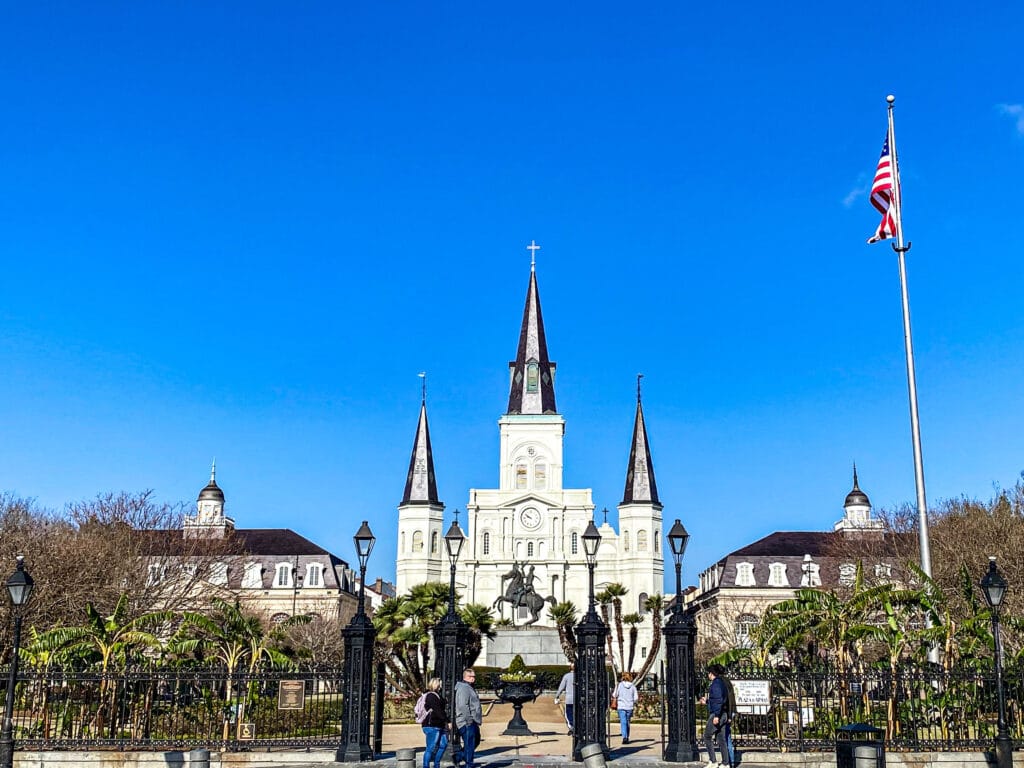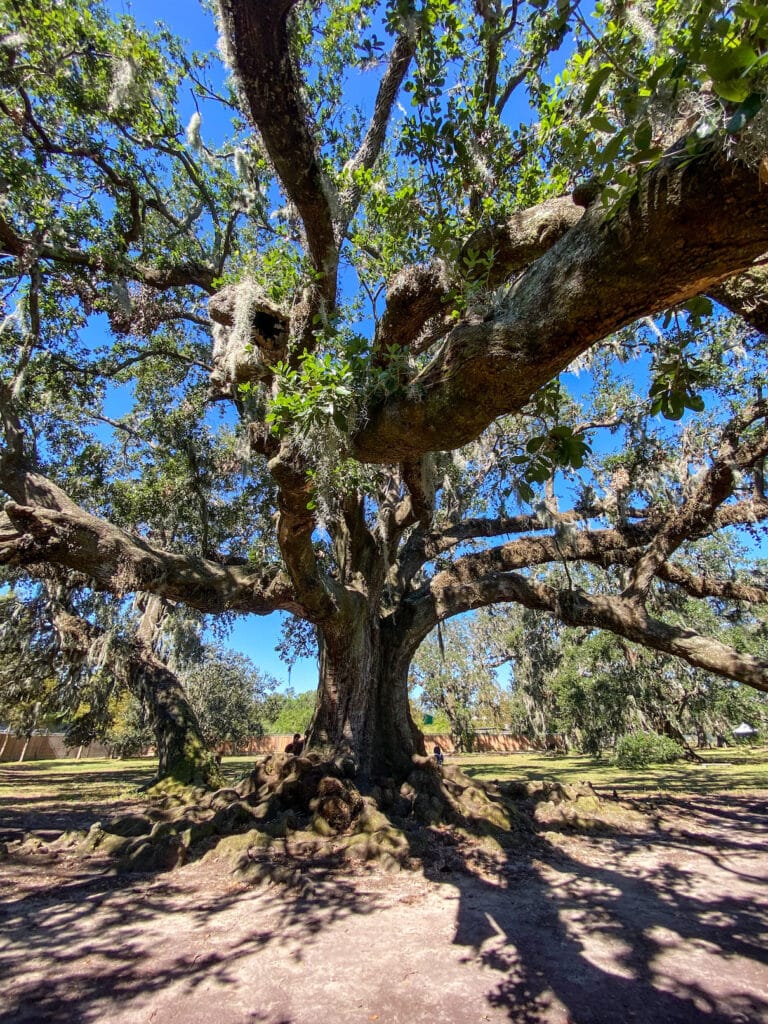Laissez les bon temps rouler!
Let the Good Times Roll!
And roll they will during your visit to New Orleans! The Crescent City (one of its many nicknames) is notorious for over-the-top experiences for all your senses! Tucked along coastal Louisiana, The Big Easy is the culinary heart of creole food with an abundance of culture and creativity.
Disclosure: Some links on our site are affiliate links. If you purchase a linked item, we will make a commission, at no extra charge to you.
This major port city of the south struggled to take off in its early years. But the early 1800s allowed the city to begin taking the shape of the city we all know and love. Those early years were a melting pot of cultures still present today minus the pirates.
Random Facts
- New Orleans was the first city to host Opera in the United States. Sylvain by Ernest Gretry in 1796.
- The world’s first movie theater, Vitascope Hall, was in New Orleans.
- The Superdome is the largest enclosed stadium in the world.
- Claims to be the most haunted city in America (Although Savannah makes the same claim.)
- Antoine Peychaud created America’s first mixed drink in a French Quarter bar. It was called the Sazerac. The Sazerac is the official cocktail of the city. It includes ¼ oz Absinthe, 1-½ oz whiskey or cognac, a sugar cube, and three dashes of bitters.
- The first form of dental floss was invented here by Levi Spear Parmly.
- The city has lived under three different flags: the French, the Spanish, and the French again before the United States.
- While Baton Rouge is now the capital, New Orleans was named the capital city twice.
- City Park is one of the largest parks in the nation. It was once a popular place for Creole men to meet and duel.
- The game of poker originated in NOLA. The first game was played in the 19th century with a 20 card deck.
New Orleans is not lacking in interesting things to see. Regardless of your preferences, you can find what you are looking for in The Big Easy! Grab some comfy shoes and hit the streets for a walking tour!
Louis Armstrong Park (Tremé)
Just north of The French Quarter sits Louis Armstrong Park honoring the great jazz musician. The arched entry will lead you to many great sculptures inside the park, as well as Congo Square. The square is an open space in the southern corner (enter through the arch and head left) of Armstrong Park. The space was used by slaves and free blacks throughout the 19th century as a meeting place. The area played a substantial role in the development of jazz. The space is still considered a spiritual gathering place for the local voodoo practitioners
Banksy Umbrella Girl (Tremé)
The British graffiti artist completed the piece in 2008. The piece is based on the iconic Morton Salt girl with Banksy’s version showing the umbrella as the source of the rain. It is believed to represent the failure of the levee system during the storm surge caused by Hurricane Katrina in 2005.
Pirate Jean Lafitte’s House
Although currently just a rental apartment, history lovers may want to loop past the former home of the pirate Jean Lafitte. Lafitte and his brother Pierre were French privateers in the early 1800s. The brothers ultimately fought in the Battle of New Orleans after a deal with then General Andrew Jackson. The Lafitte Blacksmith Shop is still open in the French Quarter to grab a drink.
The French Quarter
You have skirted the edge of the famed French Quarter, but as your walk continues you will be entering the heart of it. If you are ready for a bite to eat, a small grocery store (Verti Marte) at the corner of Gov Nicholls and Royal St has an amazing sandwich called All that Jazz.
French Market District
The area predates European colonization as a Native American trading post. Today the area is still an open-air market with a variety of shops and restaurants. Although rebuilt and renovated a number of times it is the oldest market of its kind in the United States.
Jackson Square

One of New Orleans most recognizable spaces, Jackson Square is a National Historic Landmark.
Tip: For a great view of the space, grab some Cafe du Monde to go and head up the stairs adjacent to Cafe du Monde to the canon. Sip your chicory coffee, eat your beignets and enjoy a full view of Jackson Square before heading across the street to the park.
The square is named for the large bronze statue of Andrew Jackson in the center of the square. The area is also home to an open-air artist colony (along its iron fence) and is surrounded by a mix of residential and commercial properties.
Behind the square, you will find more to see. The Cabildo (the old Spanish Governor’s Mansion) Museum is separated from the St Louis Cathedral by Pirate Alley. If no services are happening you can peek into St Louis Cathedral to see some amazing artwork. The cathedral is the oldest active cathedral in the United States.

Just one block long Pirate Alley is said to have been a haven for pirates. While that is the legend, many find it hard to believe that pirates would choose a place between a church and the governor’s mansion to hang out. Pirate history aside, a stroll down the alley will take you past Faulkner House. Named for William Faulkner, the house is where the author penned his first novel.
Along your walk be sure to peek into the garden behind St. Louis Cathedral to see what locals have named “Touchdown Jesus”
Ready to move along? Time to jump in the car for a few drives.
Chamlette Battlefield
Just downriver from New Orleans is the Chalmette Battlefield. In 1815 the field was a sugarcane farm, but now it marks the spot where an outnumbered ragtag team led by Andrew Jackson defeated the British. The Battle of New Orleans is often referred to as the greatest American land victory. The victory was achieved by General Andrew Jackson and his hastily assembled force of U.S. regulars, Choctaw Indians, pirates (led by Jean & Pierre Lafitte), and volunteers (led by Thomas Jefferson Beale).
Grab a drink at the bar Andrew Jackson met with Jean & Pierre Lafitte to recruit the help of the privateers in the battle and read more about Thomas Jefferson Beale and his rifleman.
Lake Pontchartrain Causeway
You will be driving on the longest bridge in the world as you cross Lake Pontchartrain. At 23.83 miles long, it is a hike to cross. Keep in mind there are no viewing areas and the trip back is a toll. Once you arrive on the other side you will find Covington, LA. The city offers a nice brewery (Abita Brewery), a hot spring, and the home of oddities and found objects, Abita Mystery House.
New Orleans Garden District (Uptown)
The Garden District is the area where you will find sprawling oaks and shaded lanes leading you to large, very large homes. While the French Quarter was settled by the first Creole settlers, the Garden District was founded by Americans who arrived in the early 19th century and consciously distanced themselves from Francophone New Orleans.
The district is a great place to walk off some of the food you are undoubtedly enjoying while visiting the city. St. Charles Avenue is one of the most popular strolls. The street forms the northern border of the district and is fronted by mansions and historic homes. You can walk the neighborhood or grab a streetcar to tour.
On the southern border of the Garden District, you will find Magazine Street. While you won’t find the over-the-top enormous homes along Magazine Street, you will find a combination of local restaurants, shops, and galleries.
Tree of Life

Located in New Orleans’ Audubon Park the Tree of Life or officially known as the Étienne de Boray Oak. The tree is estimated by the Live Oak Society to be a 500-year-old live oak. Named for the man responsible for bringing sugar cane to the area and the first mayor of New Orleans. But it is likely the oak existed before Boray. The land it sprawls across eventually did neighbor his plantation.
The current name “Tree of Life” was given to the tree by locals. Its gnarled and knobby limbs are a favorite among the locals and are noted for its climbable branches (although likely not climbing approved). It is a favorite location for wedding photos.
New Orleans Cemeteries
Burying the dead in a city built below sea level created a problem for early residents. Their solution was to build above-ground tombs for the departed. The result created hauntingly beautiful mazes of tombs scattered throughout the city.
There are many guides to New Orleans cemeteries. Be sure to be respectful and check restrictions before visiting.
Mardi Gras
Opened celebrations of Mardi Gras date back to the 1730s, but it took another 100 years to resemble the celebration we know today.
- Masks are mandatory. It is illegal to ride a Mardi Gras float without wearing a mask.
- New Orleans did not host the first Mardi Gras party in America. That distinction goes to Mobile, AL.
- The official colors of Mardi Gras started in 1872. Purple stands for justice, green for faith, and gold for power.
The dates and festivities vary. Check Mardi Gras New Orleans for the latest information.
With many activities focused on nearly every holiday be sure to give Visit New Orleans Instagram account a look before your trip to ensure you don’t miss great activities like these.

